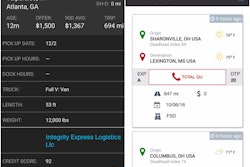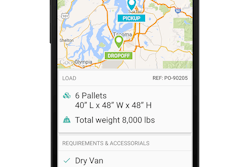Follow this link for the previous installment in this series.
The local loads Sergio Marin’s small fleet is moving via the tech-enabled Convoy brokerage in and around Los Angeles aren’t always priced well below what’s feasible for his operation, but it happens often enough. All load offers that come his way through the Convoy app are offered for acceptance or rejection with a Convoy-determined price associated with them. As long as the rate is right, this holds the potential of speeding up the matching process, of course.
But if it’s not, negotiation over the phone has always been possible, but a relatively new option in the Convoy app is to bid the load up. Response times have lagged with its implementation, however. Tech support at the company is well aware of it and are working on it, Marin says. “Staffing seems to be the problem. When I’ve bid, somebody will call me back and we’ll negotiate.”
Convoy, as with Loadsmart and other would-be freight market disruptors, is attempting to provide a certain level of automation and data science into its pricing that “better reflects the market” than what arises from the typical process, often tilted against carriers in one-on-one spot negotiations. Pricing algorithms often include spot rate averages from familiar sources like DAT and Truckstop.com, historical data from within the brokerages’ own networks and more.
“I’d love to say rates are always better,” Lewis says about Convoy, compared to what’s typical for owner-operators, “but maybe not in some areas.” What’s different otherwise is the margin on which he hopes Convoy can operate. Loadsmart’s Diego Urrutia echoes Lewis’ contention that a tech-enabled brokerage out to be able to operate on a 5-10 percent margin, rather than the more typical 10-20 percent in traditional brokerage. Such operations’ ultimate hope, and selling point to both shippers and carriers, is that the difference can be passed on to both sides in improved revenue/income.
What’s more likely, suggests Texas-based broker Arrive Logistics CEO Matt Pyatt, is that such claims may be little more than PR, adding however that “it’s an unknown how this marketplace ultimately plays out.”
Rather, more automated brokers, as Barry Conlon has suggested in his thoughts on tech adoption by traditional brokerages, will increasingly put pressure on traditional counterparts to compete at their margin level if players are to survive long-term.








